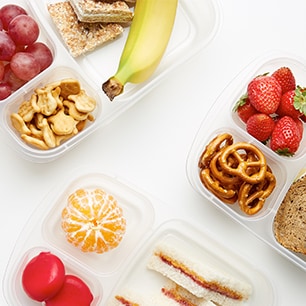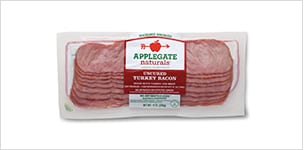For many families, August is a time to prepare for children going back to school, which often includes changes in eating schedules. When you’re starved for time, it’s easy to fall into the habit of picking up fast food such as burgers and fries, chicken nuggets, and pizza. Consuming too much sodium, processed foods, and sugar-sweetened beverages can increase the risk of obesity, a serious problem in the US that puts children and teens at risk for poor health.1
Parents play a key role in helping their kids develop the tools to make wise decisions about the foods they eat. If you plan and take small steps toward your nutrition goals, it can really pay off in the long run. We have some smart and simple ideas for getting the entire family into better eating routines.

Make It Easy as 1-2-3-4-5-6
Stock up on the right foods at home to make it easy to eat balanced meals and snacks. Check out these six strategies for helping your family eat better.
1. Produce Habits
As a rule of thumb, half your plate should be fruits and vegetables. Be creative! There are so many ways to make this food group more enticing to little ones by varying its presentation.
- Add interest by cutting fruits and vegetables into fun shapes such as stars or hearts.
- Give veggies creative names like Broccoli Trees and Super-Vision Carrots.
- Serve them with sauces and dips such as hummus, salsa, low-fat ranch dressing, honey mustard, or teriyaki sauce.
- Make your own Greek yogurt dip for our Kids Bento Box Lunches.
- Both kids and adults enjoy food on a stick. Assemble colorful fruit kabobs, or try our Barbecue Chicken Kabobs over Cheesy Rice with Strawberry Bites recipe.
2. Grains of Goodness
Aim to make at least half of your grains whole grains. Swap out refined grains for whole grain varieties such as quinoa, brown rice, and oats. Discover the benefits of sprouted grains.
Breakfast Ideas:
- Look for whole grain waffles in the frozen foods section. Use Better Choice shelf tags to help you select those with less fat, saturated fat, and sodium, and with more fiber.
- If you have more time on the weekend, try our Apple Pie Pancakes with Turkey Bacon recipe, featuring whole grain oats.
Dinner Solutions:
- Use whole wheat breading in kid-friendly recipes, such as our Crispy Chicken with Apple Relish and Green Beans featuring GreenWise Sprouted Multigrain Bread.
- Naturally gluten-free brown rice is a great way to get whole grains. Try it in our Cowboy Chicken and Rice or Grilled Chicken and Vegetable Bowl.
3. Smart Dairy
As the primary source of calcium in American diets, dairy products help strengthen our bones and teeth and maintain our bone mass. Dairy intake is especially important during childhood and adolescence, when bone mass is being built.2 It’s best to stick with low-fat or nonfat milk or dairy products.
Try these easy ways to get more dairy:
- Grab a yogurt for a snack. Use Better Choice shelf tags to help select yogurts with less fat, saturated fat, and added sugars.
- Enjoy string cheese with fruit such as grapes.
- Mix up a smoothie with yogurt or milk and frozen fruit. Our Kids PB-Berry Smoothie makes a tasty option.
- If you are lactose intolerant and looking for nondairy options, check out these eating tips.
4. Protein Routine
Mix up your proteins with diverse sources that include nutrient-dense and plant-based options such as seafood, lean meats and poultry, eggs, legumes (beans and peas), nuts and seeds, and soy products.
Here are a couple of ideas:
- Whether you’re a vegetarian or not, everyone can enjoy plant-based meals. Do meatless Monday with our delicious and hearty Lentil Bolognese over Zoodles.
- Serve fish twice a week. The beneficial EPA and DHA omega-3s in salmon and other seafood may help support brain health. Try this kid-friendly recipe: Parmesan Salmon Bites and Summer Fruit Salad.
5. Limit Added Sugars
Many American children and adults consume too much added sugar, which is prevalent in so many foods and beverages. Be sure to monitor your added sugar intake and make substitutions for sugary drinks. Follow these tips for limiting added sugars for kids.
6. Snack Right
Make it easy for children to choose healthy snacks by keeping them on hand and ready to eat.
- Place fresh fruit in a bowl on the counter.
- Have precut fruits and vegetables available in the refrigerator.
- Fill your pantry with whole grain granola bars and nut butter spreads
- Here are some other balanced snacking ideas.
Be a Role Model
For better or for worse, children watch (and imitate) much of what their parents do. Modeling good nutrition is essential. You can’t expect your kids to eat vegetables such as spinach or broccoli unless you do too. Studies show that one of the most powerful predictors of children’s dietary patterns is that of their parents.3 Chances are, if you make wise food choices, so will your little ones.
Keep It Positive
Parents want the best for their children, including good nutrition. However, forcing a child to eat something he or she doesn’t like can make food a negative experience.4 Similarly, using dessert as a reward for eating dinner takes away from enjoyment of the meal itself. Keep mealtime positive by letting your child try new foods of their choosing. Smelling and touching food is just as important as eating it. Did you know that it might take 20–30 times of being exposed to a food for a child to accept it? A few complimentary words to your child can go a long way.4
Get Kids in the Kitchen
Involving your children in planning and preparing family meals encourages them to try new foods. It’s also a great strategy for improving the quality of their diets as well as developing cooking skills.
Talk to your kids regularly about wise snack choices and balanced meals. Let them help you shop for ingredients. Teach them to read food labels and look for Better Choice shelf tags at Publix to help make smarter selections.
In the kitchen, select age-appropriate tasks so kids can participate safely. When they are old enough, put them in charge of one dinner a week. At the end of the meal, don't forget to praise the chef!
Focus on Family Meals
Eating together as a family has a wide range of benefits. Not only is it a wonderful way for parents and kids to bond, but it can help improve everyone’s nutritional habits. Studies suggest that children and adolescents who take part in family meals at least three times per week are more likely to be in a normal weight range and have healthier eating patterns than those who do not.5 The comforting ritual of eating together creates opportunities for parents to introduce kids to new foods and to be role models for eating right. Read more about the benefits of family meals.
Eating habits are formed early in life, so it’s important for children to establish healthy routines. Getting your kids to eat right every day may be a challenge, but teaching smart nutrition choices overall at a young age can instill balanced eating into adulthood.
For the Love of You
Choosing how you eat is uniquely personal. It’s about your needs, your preferences, and your goals. As your wellness ally, Publix is in your corner with fresh ideas, recipes, and wellness icons that make it easier to shift toward wiser food choices. It’s all about you, at your very best.
Sources
1 Centers for Disease Control & Prevention (CDC). "Childhood Obesity Facts." U.S. Department of Health & Human Services (HHS). August 13, 2018.
2 ChooseMyPlate.gov. "Nutrients and Health Benefits." U.S. Department of Agriculture (USDA). June 26, 2015.
3 Pearson, Natalie, Stuart J. H. Biddle, and Trish Gorely. "Family Correlates of Fruit and Vegetable Consumption in Children and Adolescents: A Systematic Review." Public Health Nutrition 12, no. 2 (July 2008): 267-83.
4 Dennett, Carrie, MPH, RDN, CD. "Children's Nutrition: Raising Intuitive Eaters." Today's Dietitian 20, no. 3 (March 2018): 14.
5 Hammons, Amber J., PhD, and Barbara H. Fiese, PhD. "Is Frequency of Shared Family Meals Related to the Nutritional Health of Children and Adolescents?" Pediatrics 127, no. 6 (June 2011): 1565-74.

 You are about to leave publix.com and enter the Instacart site that they operate and control. Publix’s delivery and curbside pickup item prices are higher than item prices in physical store locations. Prices are based on data collected in store and are subject to delays and errors. Fees, tips & taxes may apply. Subject to terms & availability. Publix Liquors orders cannot be combined with grocery delivery. Drink Responsibly. Be 21. For prescription delivery, log in to your pharmacy account by using the Publix Pharmacy app or visiting
You are about to leave publix.com and enter the Instacart site that they operate and control. Publix’s delivery and curbside pickup item prices are higher than item prices in physical store locations. Prices are based on data collected in store and are subject to delays and errors. Fees, tips & taxes may apply. Subject to terms & availability. Publix Liquors orders cannot be combined with grocery delivery. Drink Responsibly. Be 21. For prescription delivery, log in to your pharmacy account by using the Publix Pharmacy app or visiting 


